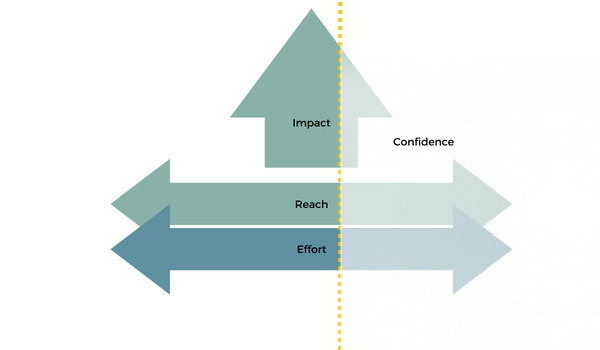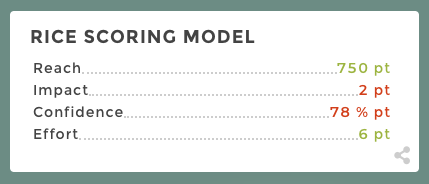RICE Scoring Model - Why should you use it?
Product managers have a lot on their plates, and roadmaps help plan and simplify product launches, optimizations, and goals. By constructing a product roadmap, product managers can be sure that team members have a clear vision of the path ahead.
But how do you construct such a roadmap? With so many moving parts, it can be difficult to know where to begin or how to structure it. You may have a clear idea of what your end goal entails, but are struggling to narrow down the steps to get there.
This is where the RICE scoring model shines.
The RICE scoring model helps a product manager prioritize the steps in a product roadmap. Managers can better determine the products, features, and other tasks to feature on their roadmaps by scoring these factors according to the 4 categories of the RICE scoring model:
- Reach
- Impact
- Confidence
- Effort
The RICE scoring model, developed by Intercom, was constructed when Intercom's product managers struggled to construct roadmaps that catered to the company's specific needs and ideas.
The reason for RICE's creation is a common occurrence for today's businesses. With so many industries, sectors, and business types, product managers experience difficulty assessing and creating a roadmap that is focused on their company's objectives.
So how does the RICE scoring model work? Let's dive into what makes the model an effective one and the benefits it can bring to your product management team.
How Does RICE Work?

The RICE model's 4 categories help evaluate all of your ideas and prioritize them to create a roadmap. Each factor is crucial to aid your product management in developing the most relevant and efficient roadmap:
Reach
The first factor in determining your RICE score is reach, which estimates how many people will hear about your project in a time period.
Because the RICE model is open-ended, you will need to define both the timeframe and what reach means to your team. For example, a web-based company may determine reach as sign-ups for a free trial, while a clothing brand may determine that a purchase qualifies as reach.
How you score reach depends on how your team defines these two factors. For example, if the SaaS company estimates that their project will drive 1,500 leads to their free trial page and 50% of them actually sign up, their reach score would be 750. On the other hand, if the clothing company thinks that 400 people will purchase their new product, their reach score would be 400.
Impact
Impact is the most difficult factor to score. Defining impact quantitatively is a near impossible task. Do you look at social media engagement? Organic traffic? Pinning down factors that explain impact is difficult, but bringing together these factors to give a rough estimate of impact can give your product team an idea of why your users will take action.
This is the most common scoring system for estimating impact developed by Intercom
- 3 = maximum impact
- 2 = high impact
- 1 = medium impact
- .5 = low impact
- .25 = minimal impact
Confidence
This component of your RICE score, like impact, is another metric that is calculated from intuitive estimates of impact, reach, and effort.
For example, if you have data to back up your reach estimate, but are relying on instinct and anecdotal insights to score your impact, your confidence score can help account for a shakier impact estimate.
Confidence is measured out of 100%, with 100% demonstrating full confidence, 80% demonstrating medium confidence, and 50% demonstrating low confidence. If your confidence score is below 50%, consider reevaluating your priorities and allocating your resources toward a more certain project.
Effort
Effort is considered the denominator for the other three factors of the RICE scoring system, and it can be accounted for more concretely.
This factor requires a product team to quantify the amount of time and resources it will take to complete a project. For example, if you need a designer and computer scientist to complete a project, and you estimate that it will take 6 "people months" to complete the roadmap, then your effort score would be 6.

Are There Other Roadmap Scoring Methods?
Although RICE is the most prevalent model for roadmap prioritization, other models are gaining traction and popularity. For example, the Kano model evaluates features for their impact on the customer’s psyche and emotions in an attempt to prioritize features that will be widely accepted.
The weighted scoring model is also a popular roadmap scoring system and bears many resemblances to the RICE Scoring Model. The weighted scoring model relies on educated guesses, but roadmap creators select their own cost-benefit criteria instead of using reach, impact, confidence, and effort.
Some other roadmap scoring systems include:
- Value vs Effort
- Story Mapping
- Opportunity Scoring
- The Product Tree
-
The MoSCoW Method
Why is the RICE Scoring Model Important?
Making changes to your product or creating a new product entirely is the most time and resource-consuming aspect of a business operation. Using a benchmarking system to evaluate your projects can help you avoid allocating too many resources toward a project that was never a good idea to begin with.
Although the RICE scoring model is not a surefire prediction of your project's success, it can poke holes in areas of your roadmap that are uncertain, weak, or just not that well thought out. Be sure to consult other resources when planning your product roadmap and evaluating your company's product journey.


.png?width=710&name=CTA%20Template%20%E2%80%94%20Free%20Trial%20(2).png)